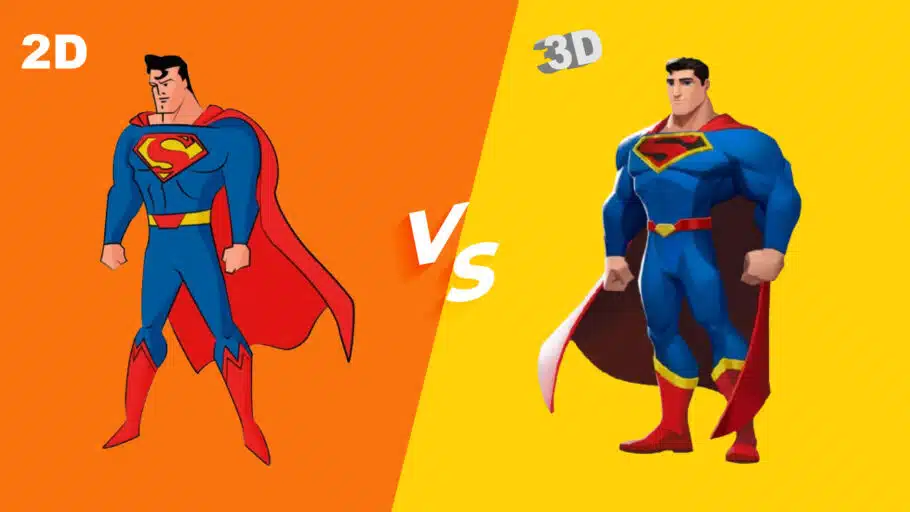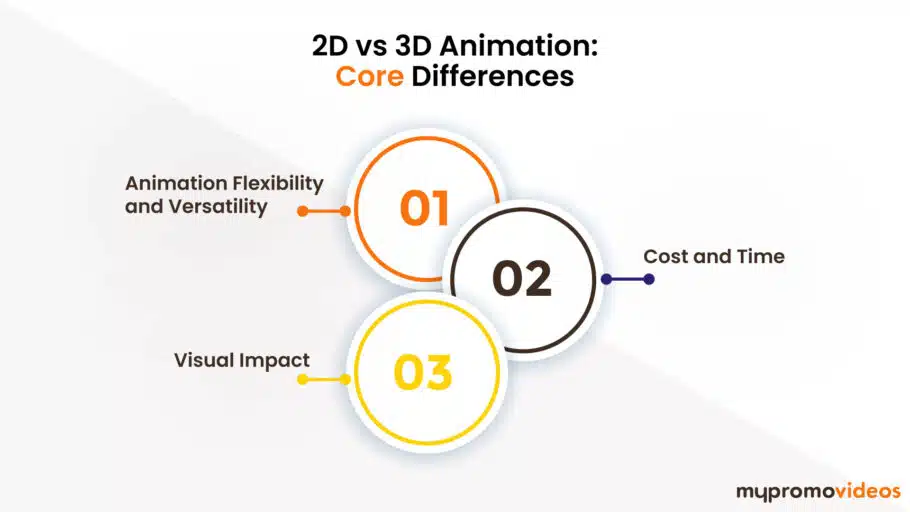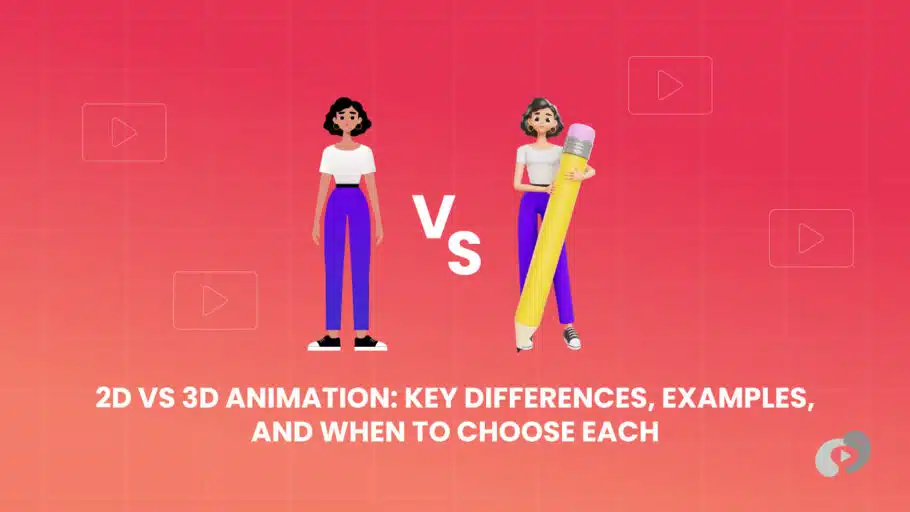Last Updated on January 4, 2025
Article Contents
2D Animation vs 3D Animation: Key Differences and Examples
Animation is one of the most versatile art forms in the digital world, used in everything from entertainment to marketing. It allows us to create captivating visual experiences that wouldn’t be possible with traditional filming. When diving into animation, one of the most common questions is 2d animation vs 3d animation. Whether to choose 2D or 3D animation for your project?

While both forms of animation can be highly effective, they each have their own unique strengths, weaknesses, and applications. In this guide, we’ll explore 2D vs 3D animation differences, provide examples, and help you determine which is best for your project.
What is Meant by Animation?
Animation refers to the process of bringing static images to life by sequencing them in such a way that they create the illusion of movement. By using technology, animations can simulate life-like actions, whether in 2D (two-dimensional) or 3D (three-dimensional) forms. This technique has become integral in storytelling, education, gaming, and branding, providing an immersive experience that engages viewers beyond static visuals.
What is 2D Animation?
2D animation involves creating characters, environments, and objects in two-dimensional space. Animators draw each frame by hand or use software to design and move flat images that can be animated sequentially. This traditional animation style is often known for its simplicity and flat appearance, as it focuses on height and width but lacks depth.
One of the hallmarks of 2D animation is its classic and timeless appeal. From hand-drawn cartoons like Looney Tunes to modern digital animations, 2D animation remains highly relevant in the world of visual storytelling.
Examples of 2D Animation
- Disney’s “The Lion King” (1994): This iconic film is a prime example of traditional 2D animation at its peak, where hand-drawn frames create a fluid narrative.
- “Avatar: The Last Airbender”: This series uses 2D animation to craft intricate character movements and stunning visuals with a distinct, recognizable style.
- Explainer Videos: Many corporate explainer videos use 2D animation to deliver simple, clear messages in a visually engaging way.
What is 3D Animation?
3D animation differs from 2D in that it creates characters, environments, and objects in a three-dimensional space, offering a greater sense of realism. 3D models are built with depth, allowing them to move and rotate on all axes. This kind of animation is heavily used in films, video games, and VR (virtual reality) experiences due to its immersive quality.
3D animation allows for more complex lighting, textures, and physics-based movements, giving it a polished, life-like feel. The technology behind 3D animation has advanced significantly, enabling animators to create highly realistic environments and characters.
Examples of 3D Animation
- Pixar’s “Toy Story” (1995): The first full-length film to use 3D animation, Toy Story revolutionized the industry by showing what computer-generated 3D models could achieve.
- “Frozen” (2013): Disney’s Frozen is a perfect example of how 3D animation brings characters and their environments to life with stunning visual effects and realism.
- Video Games: Popular video games like Fortnite and The Last of Us use 3D animation to create lifelike characters, worlds, and gameplay dynamics.
2D vs 3D Animation: Core Differences
The decision between 2D and 3D often depends on the animation styles that best align with the project’s goals and audience expectations. There are several critical differences between 2D and 3D animation that affect how they are created, perceived, and used in various industries. Here’s a breakdown of key 2D vs 3D animation differences:

Animation Flexibility and Versatility
- 2D Animation: More straightforward in its design process, 2D animation tends to be quicker and less resource-intensive compared to 3D. It’s ideal for projects that require rapid production and simpler visuals. 2D animations are often used for explainer videos, traditional cartoons, and educational content due to their simplicity and ease of use.
- 3D Animation: Offers greater flexibility when it comes to creating detailed, realistic movements and environments. The depth and dimension provided by 3D animation allow animators to create more complex scenes and actions. This is why 3D animation is a go-to for high-budget projects like feature films, advanced video games, and VR applications.
Cost and Time
- 2D Animation: Generally, 2D animation is less costly and faster to produce, especially when dealing with simpler designs and limited animation. However, the process can become more time-consuming if intricate hand-drawn frames are required.
- 3D Animation: Producing 3D animation is often more resource-intensive and requires more advanced technology. The modeling, rigging, and rendering phases can be time-consuming, resulting in higher production costs. But for projects that demand high levels of detail and realism, 3D animation is worth the investment.
Visual Impact
- 2D Animation: While 2D lacks the depth and realism of 3D, it shines in its ability to present artistic, stylized visuals. The “flat” look can create a charming, nostalgic feel, making it a popular choice for cartoons and creative storytelling.
- 3D Animation: If your goal is to create something that looks realistic, 3D animation is the way to go. The use of lighting, shadows, and textures adds a layer of sophistication that 2D animation cannot achieve.
When to Choose 2D vs 3D Animation
When deciding between 2D vs 3D animation, consider the following factors:
- Budget: If your project is operating under a tight budget, 2D animation might be the better option, as it typically costs less to produce. 3D animation, while more expensive, offers higher visual fidelity, which might be necessary for larger projects.
- Timeline: For faster turnarounds, 2D animation is often the way to go. If you have more time and require more detailed work, 3D animation can be worth the longer production cycle.
- Target Audience: Consider your audience. For younger children, 2D animation is often more engaging with its bright, simple visuals. For older audiences or for projects like video games, 3D animation offers a more immersive experience.
- Story Requirements: If your project requires a lot of movement and depth (like in action scenes or sci-fi settings), 3D animation will likely be more effective. For simpler storytelling or artistic narratives, 2D animation can deliver a more creative, stylized look.
Future of 2D vs 3D Animation
Looking ahead, both 2D and 3D animation will continue to evolve. While 3D animation technology is constantly pushing the boundaries of realism and immersion, 2D animation is enjoying a resurgence in new forms. Hybrid animation, which blends 2D and 3D techniques, is becoming more popular, offering the best of both worlds.
For example, films like Spider-Man: Into the Spider-Verse combined the aesthetic of 2D animation with the depth and fluidity of 3D animation, resulting in a visually stunning hybrid style.
Conclusion
Choosing between 2D vs 3D animation ultimately depends on your project’s needs, goals, and budget. 2D animation is perfect for projects that require a classic, artistic approach with a quicker turnaround. 3D animation, on the other hand, offers unparalleled realism and depth, making it ideal for high-budget productions that require visual sophistication.
Both forms have their place in the world of animation, and knowing when to use each will ensure your project stands out, regardless of the format. With continuous advancements in both areas, the future of animation is bright, blending creativity and technology in new and exciting ways.

